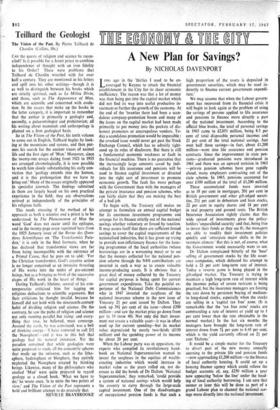Teilhard the Geologist
CAN the quests of religion and science be recon- ciled? Is it possible for a Jesuit priest to combine independence of thought with an iron fidelity to his Order? These were problems that Teilhard de Chardin wrestled with for over half a century. They are mentioned in his letters and spill into his other writings—though it is as well to distinguish between his books which are strictly spiritual, such as Le Milieu Divin, and those, such as The Appearance of Man, which are scientific and concerned with evolu- tion. In the essays that make up the books in the latter category, it is important to remember that the author is primarily a geologist and, secondly, a palaeontologist and prehistorian; all his writing about mammals and anthropology is planted on a firm geological basis.
So in The Vision of the Past, his tenth volume to come out in English, Teilhard begins by look- ing at the mountains and oceans, and then pur- sues his search for the ancient traces of animal life and the first signs of 'Man.' Moreover, since the twenty-one essays dating froni 1921 to 1955 are arranged chronologically, it is now possible to watch him slowly substantiating his early con- viction that 'geology extends into the human, and it is this prolongation that we have to bring out.' Many of the essays originally appeared In specialist journals. The findings submitted in them are largely based on his own practical experience in the field; they are observations arrived at independently of the principles of his religious faith.
This needs stressing if the method of his approach as both a scientist and a priest is to be understood. In The Phenomenon of Man the word 'God' does not occur until the epilogue, and in the twenty-page essay reprinted here from the 1925 January issue of the Revue des Ques- tions Scientifiques on 'The Transformist Para- dox,' it is only in the final footnote, when he has declared that transformist views are far from being incompatible with the existence of a Primal Cause, that he goes on to add: 'For the Christian transformist, God's creative action is no longer conceived as an intrusive thrusting of His works into the midst of pre-existent beings, but as a bringing to birth of the successive stages of His work in the heart of things.'
During Teilhard's lifetime, several of his con- temporaries criticised him for tagging on religious deductions to scientific arguments. But their criticisms he thought invalid, because he himself did not hold with the nineteenth-century habit of dividing religion and science. On the contrary, he saw the paths of religion and science not only running parallel but rising; and every- thing that rose, he believed, must converge. Around the earth, he was convinced, was a belt of thinking enerc■ --'1 have ventured to call [it] the Noosphere- --and it was in this belt that geology had its natural extension. Yet the paradox remained that while geologists were quite prepared to study all the concentric spheres that made up the universe, such as the litho- sphere, hydrosphere or biosphere, they entirely neglected the Noosphere created by thinking beings. Likewise, many of the philosophers who studied 'Man' were quite prepared to regard geology as a closed book. 'What we have to do,' he wrote once, 'is to unite the two points of view,' and The Vision of the Past represents a bold and brilliant attempt to do precisely that.
NEVILLE BRAYBROOKE





























 Previous page
Previous page